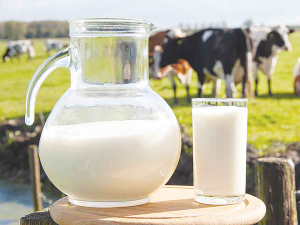Fonterra slashes forecast milk price, again
Fonterra has slashed another 50c off its milk price forecast as global milk flows shows no sign of easing.
 Fonterra’s latest announcement – bringing the season’s mid-point down to $6.25/kgMS – is a worrying sign.
Fonterra’s latest announcement – bringing the season’s mid-point down to $6.25/kgMS – is a worrying sign.
OPINION: Not so long ago, a payout starting with a six would have been happily accepted by the dairy sector.
Today – with input inflation running rife and interest rates showing no signs of abating – a payout starting with eight is the new norm.
That’s why Fonterra’s latest announcement – bringing the season’s mid-point down to $6.75/kgMS – is a worrying sign.
Last season, dairy farmers produced 1.39 billion kgMS, so with the midpoint dropping $1.25 that is almost $1.8 billion not coming into the country’s economy. And this doesn’t just affect Fonterra suppliers. Other milk processors are also facing the heat. NZ’s peak milk season could make things worse.
The key driver of the weak short-term price outlook is weak Chinese demand, noting that China is comfortably our largest dairy market.
Unlike most economies post their Covid lockdowns, China’s post lockdown bump in economic activity has underwhelmed expectations.
Analysts have cut their outlook for Chinese economic growth for 2023 from 6.2% in June, to 5.7%, and then to 5.2%.
Many dairy farmers are bracing for losses and making changes to the way they farm, and hoping the market will rebalance.
Global milk supplies are subdued and very likely to contract further as farmers globally are not making money at current farmgate prices.
Any tightening in supply will help rebalance the market, but we are now heading into peak seasonal supply for the Southern Hemisphere dairy-exporting nations.
New Zealand’s spike in milk supply in the coming months means there will be more product to sell in the near term, while the market is still weak.
Ironically, this could lock in a payout starting with a six.
Dairy prices have jumped in the overnight Global Dairy Trade (GDT) auction, breaking a five-month negative streak.
Alliance Group chief executive Willie Wiese is leaving the company after three years in the role.
A booklet produced in 2025 by the Rotoiti 15 trust, Department of Conservation and Scion – now part of the Bioeconomy Science Institute – aims to help people identify insect pests and diseases.
A Taranaki farmer and livestock agent who illegally swapped NAIT tags from cows infected with a bovine disease in an attempt to sell the cows has been fined $15,000.
Bill and Michelle Burgess had an eye-opening realisation when they produced the same with fewer cows.
It was love that first led Leah Prankerd to dairying. Decades later, it's her passion for the industry keeping her there, supporting, and inspiring farmers across the region.
President Donald Trump’s decision to impose tariffs on imports into the US is doing good things for global trade, according…
Seen a giant cheese roll rolling along Southland’s roads?